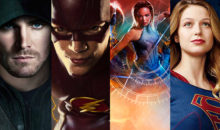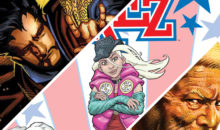Fleet-Foot Tales and Hero-Glyphs Part II: The Celestial Voyages Fragment
In our last piece on artist-archaeologist Josh Ln’s hero-glyphs discovery–or “Fleet-Foot Tales”–we discussed the possible interpretations and meanings behind the artifact entitled Conflict Amongst a League of Marvels. However, our work is not finished. In fact, just as we promised, we at G33kPron’s Art Historian branch are going to transliterate and analyze the next in a series of Ln’s discoveries: specifically Exhibit B or The Celestial Voyages Fragment. This was no mean accomplishment. In addition to utilizing the Mind Gem in order to understand the mental processes behind its creation as well as bolstering our own understandings of this matter, our Chief Information Officer G33kBot had to authorize the retrieval and usage of the Space Gem and the Time Gem as well. It should be also noted as with Exhibit A, we had to actually undertake the laborious tasks of repairing and restoring these Gems to fulfill their original functions.
In addition, unlike the Mind Gem and its greater … affinity with Exhibit A, Exhibit B’s unusual temporal and spatial structure–though hypothetically found in an unknown period of Earth’s history–necessitated the use of these three tools (and the Space Gem in particular) to … travel to various places and times in order to place matters in their proper context. So now that you know of some of our struggles with these “hero-glyphs,” dear readers, let us examine what we have learned about Exhibit B.
As you can see, there are three central figures in this sequential narrative. On the left is what appears to be a member of a mythological Elder Race: the Sidhe or the Elves. Certainly, the very bright colours that Fae beings are told to favour seems very much a characteristic of this being: whose actual name we have not been able to pronounce as it utilizes syllables and intonations unfamiliar to human vocal cords, mouth structures, or–even with Mind Gem augmentation– our current mental capacity. However, note his very direct–almost linear–bearing and the hand-gesture that he is creating with his left hand: the left hand in some cultures signifying a receptive element. At first, we thought that perhaps he is attempting to cast some kind of incantation or spell on the right-hand figure. However, the gesture itself–while seemingly questioning–can also be interpreted as either a greeting or a farewell. It can actually be seen as both of these elements simultaneously.
Yet there is that questioning aspect to consider as well. The Elf-Lord, if his pointed ears, gaudily-coloured uniform, the half-obscured celestial arch on the right side of his chest and his straight-forward gesture–with what seems to be indicative of a culture or mentality of highly structured oaths and promises that is incapable of lies (at least upon pain of death or the unravelling of the structure that keeps them from devolving into the chaos of star-stuff from whence they came), much in the way of the ancient Fae of Celtic and Nordic folklore and fantastic literature, there is the artifact on his hip to consider. It resembles a recording device–or a weapon of some kind–or perhaps something that has different phases of usage. He seems to be both questioning and asking something of the figure on the right-hand side.
And what a strange figure the latter truly is. After some translation of the hero-glyph, we have determined that he is a human figure called something along the lines of Tiberius. It is particularly odd given that Tiberius is an ancient Latin name and though the latter have obviously had contact with Celtic culture and even Germanics, there are other details to consider here. Tiberius is a hero and has the rank of something equivalent to a Praetor: a commander or a captain acting on behalf of another force. What is even more puzzling is that he is dressing in the same Fae-like uniform–of a golden hue–and he seems to be sitting on a throne: as perhaps a representative of an empire. Perhaps he is symbolic of a changeling that the Elf-Lord has trained, or raised to influence humankind from the inside and the deference that the latter shows Tiberius is merely a formality: one that belies his true power. Yet this is ignoring the fact that despite the throne, both figures are at the same height: indicative of some kind of–dare we say–equality. And then there are the other images in this narrative to consider.
Even though Tiberius sits on his throne, behind the Elf-Lord is a strange glyph of concentric circles and cylinders that appears to be some kind of vessel. Thus both sides have a power behind them: though the Elf-Lord does appear to be reporting to Tiberius. This vessel–which appears to be hovering in mid-air as something akin to a spiritual genius or something that happened, is happening, or will happen seems to be seeking something that is beyond the edge of the narrative. It is literally floating in space. However, both the Elf-Lord and Tiberius seem more focused–at this moment–on a bronze-gold predatory bird between them. Whether this is some kind of cursed artifact, or a symbol indicative of war is unknown. Certainly, the distance between them and every other symbol in the space seems to indicative a great peace or stillness, but a distant threat of war.
On the upper-hand corner of Exhibit B are three emblems arranged horizontally next to one another. The red symbol with its curved edges seems indicative of some kind of war-like passionate Meritocracy, the blue mirrors the emblems on the two figures as something more peaceful and distant–perhaps an open-ended Union encompassing whatever it comes across–whereas the last may well be indicative of a rising Star Empire. Whether these are other governments that the Elf-Lord and Tiberius are negotiating with, or the possible parallel pasts, futures and aspects of humankind is unknown at this time.
Yet what is really striking is the third central symbol on the upper right hand side of the narrative: the depiction of what appears to be a humanoid saurian ascendant over Tiberius. There are a few elements to consider with regards to the Saurian. He is facing the exact opposite way from Tiberius and carries the weight of a rock or another entire world in one bulky arm. It could be that the Saurian with its seeming brutishness represents the countless horrors and barbarism that Tiberius and the Elf-Lord’s Union faces in the stars. On the other hand, it could also be a threat that was already faced by Tiberius himself and conquered: but never forgotten. The fact that it is a Saurian being may also represent the reptilian Id of the human psyche that Tiberius–as representative of humans that are still evolving–are attempting to control, but unlike the Elf-Lord with the lack of such an apparent symbol above him, still utilizes as some kind of grounding or tie to the Earth and where they came from. Tiberius seems to remember his terrestrial roots amid his celestial voyages. Then again, the Saurian may just symbolize its traditional fertility roots in Earth mythology: or at least with regards to Tiberius.
The linear structure of this narrative is deceptive with all of these possibilities and the story continuing over the edges of the overall image. At the same time, while many of these symbols are in doubt and it’s unknown whether the Elf-Lord or the hero Tiberius are rivals, superior and subordinate, or heroic comrades, it is clear that they symbolize a kind of hope or redemptive narrative: as possibilities that have not happened yet. Certainly it is no coincidence that the three possible images of empires–perhaps reminiscent of Heraclitus’ archetypal symbols of humanity’s hydra of eros (desire), the more orderly shape of logos (reason), or the rising lion form of thumos (courage or duty)–is right above the Elf-Lord’s head. He is always cognizant of what Tiberius is capable of: and, perhaps, what he and his own kind are capable of doing as well even as they continue to voyage further past vistas of sentient understanding.
And though this story, like Exhibit A, seems to have no end in sight thus ends this segment of Fleet-Foot Tales and Hero-Glyphs. Stay tuned next time for our next segment: in which we will discuss the third narrative found by Josh Ln known as The Beatific Agony and the Secret College of Marvels and Daimons.
Josh Ln’s original excavated work and restorations of the rest of the “Fleet-Foot Tales” can be found, without translation, in Hero-Glyphics, Proof All Those Time Travel Story Events Were Real for the curious at your perusal and at your leisure. And, as we end this segment, we would like to leave you with these words we transliterated as best we could from the hand-gesture of our Elf-Lord friend, “Live long, and prosper.”








